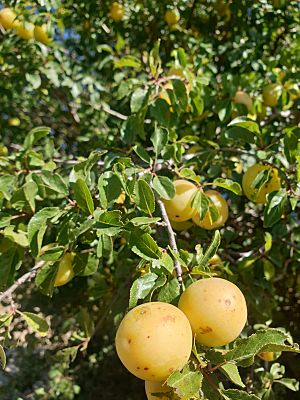Italian plum facts for kids
Quick facts for kids Italian plum |
|
|---|---|
 |
|
| Conservation status | |
| Scientific classification | |
| Genus: |
Prunus
|
| Species: |
cocomilia
|
| Synonyms | |
|
|
The Prunus cocomilia is a type of plum tree. It is often called the Italian plum because it grows naturally in many parts of southern Europe. This plant is known for its fruit, which is a kind of plum.
Contents
What is the Italian Plum?
The Italian plum, or Prunus cocomilia, is a plant that belongs to the Prunus family. This family includes many well-known fruits like cherries, peaches, and almonds. Plums are usually sweet and juicy fruits.
Where Does it Grow?
This special plum tree is native to several countries around the Mediterranean Sea. You can find it growing wild in:
- Albania
- Croatia
- Greece
- Southern Italy, including the island of Sicily
- Montenegro
- North Macedonia
- Serbia
- Western Turkey
It prefers warmer climates and often grows in sunny areas.
What Does the Plant Look Like?
The Prunus cocomilia is a small to medium-sized tree. Like other plum trees, it has green leaves that change color in the fall. It produces flowers before its fruit appears. The fruit itself is a plum, though its exact size and color can vary.
The Life Cycle of a Plum Tree
Like most fruit trees, the Italian plum goes through a yearly life cycle.
How Does it Reproduce?
Plum trees reproduce using their flowers. Bees and other insects help to carry pollen from one flower to another. This process is called pollination. After pollination, the flowers develop into fruits. Each fruit contains a seed, or "pit," inside. If this seed is planted, it can grow into a new plum tree.
When Does it Produce Fruit?
Plum trees usually flower in the spring. The fruit then grows during the summer months. By late summer or early fall, the plums are ripe and ready to be picked. The exact timing depends on the local climate.
Conservation Status
The Prunus cocomilia is listed as "Least concern" by the International Union for Conservation of Nature (IUCN). This means that the plant is not currently in danger of disappearing. It is still common in its natural habitats. Scientists keep an eye on plant populations to make sure they stay healthy.
See also

- In Spanish: Prunus cocomilia para niños


